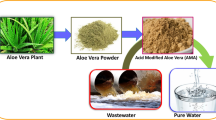Abstract
In this study, carbon nanotubes (CNTs) were synthesized from waste polyethylene bottles and their use as an adsorbent for the removal of diuron herbicide from aqueous solution was evaluated. Batch adsorption was performed by varying adsorbent dosage, initial concentration, contact time, and temperature. Kinetic models applied to experimental data indicated that the pseudo-second-order model had the best fit. The equilibrium data were analyzed using different isotherm models. The adsorption capacity of CNTs for diuron removal, determined using the Hill isotherm, was approximately 40.37 mg/g at 303 K. From thermodynamic studies, the values of ΔH° (kJ/mol) and ΔS° [kJ/(mol K)] were calculated as −17.307 and −0.0528, respectively, which suggested that the adsorption process was exothermic. The negative values of ΔG° at three different temperatures indicated that adsorption of diuron on CNTs was favorable.










Similar content being viewed by others
References
Chen GC, Shan XQ, Pei ZG, Wang H, Zheng LR, Zhang J, Xie YN (2011) J Hazard Mater 188:156
Deokar SK, Mandavgane SA (2015) Adsorpt Sci Technol 33:429
Loos R, Gawlik BM, Locoro G, Rimaviciute E, Contini S, Bidoglio G (2009) Environ Pollut 157:561
Harino H, Eguchi S, Ohji M (2012) Coastal Mar Sci 35:246
Maqueda C, dos Santos Afonso M, Morillo E, Sánchez RMT, Sayago MP, Undabeytia T (2013) Appl Clay Sci 72:175
US Environmental Protection Agency (US EPA) Annual Cancer Report (2015) Chemicals evaluated for carcinogenic potential. Office of Pesticide Programs, Health Effects Division. Science Information Management Branch, 106
Kyriakopoulos G, Doulia D (2006) Sep Purif Rev 35:97
Deokar SK, Mandavgane SA (2015) J Environ Chem Eng 3:1827
Camara MAF, Ramon MVL, Merino MAA, Castilla CM (2006) Carbon 44:2335
Deng J, Shao Y, Gao N, Deng Y, Tan C, Zhou S, Hu X (2012) Chem Eng J 193–194:339
Liu Y, Xu Z, Wu X, Gui W, Zhu G (2010) J Hazard Mater 178:462
Fernandez-Bayo JD, Nogales R, Romero E (2008) J Agric Food Chem 56:5266
Bouras O, Bollinger JC, Baudu M, Khalaf H (2007) Appl Clay Sci 37:240
Celis R, Trigo C, Facenda G, Hermosin MC, Cornejo J (2007) J Agric Food Chem 55:6650
Li YH, Wang S, Wei J, Zhang X, Luan Z, Wu D, Wei B (2002) Chem Phys Lett 357:263
Li YH, Ding J, Luan ZK, Di ZC, Zhu YF, Xu CL, Wu DH, Wei BO (2003) Carbon 41:2787
Chin CJM, Shih LC, Tsai HJ, Liu TK (2007) Carbon 45:1254
Lu C, Chung YL, Chang KF (2005) Water Res 39:1183
Sun K, Zhang Z, Gao B, Wang Z, Xu D, Jin J, Liu X (2012) Sci Total Environ 439:1
Bajad GS, Tiwari SK, Vijayakumar RP (2015) Mater Sci Eng B194:68
Foo KY, Hameed BH (2010) Chem Eng J 156:2
Deokar SK, Singh D, Modak S, Mandavgane SA, Kulkarni BD (2016) Desalin. Water Treat. doi:10.1080/19443994.2015.1132394
Bacsa WS, Ugarte D, Chatelain A, de Heer WA (1994) Phys Rev B 50:15473–15476
Kuo CY, Wu CH, Wu JY (2008) J Colloid Interface Sci 327:308
Aksu Z, Kabasakal E (2004) Sep Purif Technol 35:223
Celis R, Trigo C, Facenda G, Hermosin MC, Cornejo J (2007) J Agric Food Chem 77:6650
Sheha RR, El-Zahhar AA (2008) J Hazard Mater 150:795
Salman JM, Hameed BH (2010) Desalination 256:129
Dotto GL, Costa JAV, Pinto LAA (2013) J Environ Chem Eng 1:1137
Hu XJ, Wang JS, Liu YG, Li X, Zeng GM, Bao ZL, Zeng XX, Chen AW, Long F (2011) J Hazard Mater 185:306
Dada AO, Olalekan AP, Olatunya AM, Dada O (2012) J Appl Chem 3:38
Dawodu FA, Akpomie GK, Ogbu IC (2012) Int J Multidisc Sci Eng 3:9
Brdar M, Sciban M, Takaci A, Dosenovic T (2012) Chem Eng J 183:108
Camara MAF, Ramon MVL, Merino MAA, Castilla CM (2007) Langmuir 23:1242
Bahri MA, Calvo L, Lemus J, Gilarranz MA, Palomar J, Rodriguez JJ (2012) Chem Eng J 198–199:346
Ramon MVL, Camara MAF, Merino MAA, Castilla CM (2007) Water Res 41:2865
Yang Y, Chun Y, Sheng G, Huang M (2004) Langmuir 20:6736
Camara MAF, Ramon MVL, Merino MAA, Castilla CM (2006) Langmuir 22:9586
Acknowledgments
We thank the Science and Engineering Research Board (SERB), India, for providing us a research grant (Grant No. SB/S3/CE/077/2013) to undertake this work. Vijayakumar R.P. is thankful to the Science and Engineering Research Board, Government of India for providing SERB—Young Scientist Fellowship (Project No. SB/FTP/ETA-0235/2013).The authors would like to acknowledge Sophisticated Analytical Instruments Facility (SAIF), IIT Bombay, for allowing us to use the instrumentation facility. The authors thank Swetha, SWAN Editorial Services, for improving the language of this paper.
Funding
This work was supported by the ‘Science and Engineering Research Board (SERB) India’ under a grant no. SB/S3/CE/077/2013. Author Vijayakumar R.P. is thankful to Science and Engineering Research Board, Government of India for providing SERB—Young Scientist Fellowship (Project no. SB/FTP/ETA-0235/2013).
Author information
Authors and Affiliations
Corresponding author
Rights and permissions
About this article
Cite this article
Deokar, S.K., Bajad, G.S., Bhonde, P. et al. Adsorptive Removal of Diuron Herbicide on Carbon Nanotubes Synthesized from Plastic Waste. J Polym Environ 25, 165–175 (2017). https://doi.org/10.1007/s10924-016-0794-3
Published:
Issue Date:
DOI: https://doi.org/10.1007/s10924-016-0794-3




